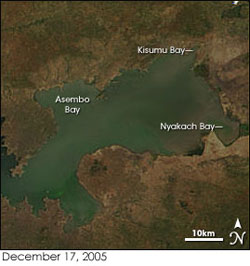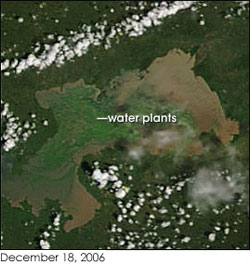Alien water weed re-invades Lake Victoria
Alien water weed re-invades Lake Victoria
Rhett A. Butler, mongabay.com
February 27, 2007

These images show the Winam Gulf, in the northeast corner of Lake Victoria in Kenya. In December 2005, when the right image was taken, the lake appeared to be clear. In November and December 2006, however, unusually heavy rains flooded the rivers that feed into the Winam Gulf. The rain and floods raised water levels on the lake and swept agricultural run-off and nutrient-rich sediment into the water. As a result, the Winam Gulf was brown when the Moderate Resolution Imaging Spectroradiometer (MODIS) on NASA’s Terra satellite took the top left photo-like image on December 18, 2006. Vegetation around the lake was dramatically greener due to the rains. Photo and caption text courtesy of the MODIS Rapid Response Team at NASA GSFC; photo and additional caption information courtesy Assaf Anyamba, Goddard Earth Sciences Technology Center (GEST/UMBC) and NASA/Goddard Space Flight Center, Biospheric Sciences. |
Water hyacinth has re-invaded Lake Victoria, choking thousands of acres (hectares) of the lake’s surface in Kenya, according to satellite pictures released by NASA.
The species, which is originally from South America but today is a costly invasive species worldwide, first established itself in Lake Victoria, Africa’s largest lake, in 1989. By 1998 the aquatic plant, which NASA says is “among the world’s most noxious invasive weeds”, covered an estimated 20,000 hectares (about 77 square miles) of Winam Gulf, in the northeast corner of Lake Victoria in Kenya. Aggressive efforts to fight the plant — which included manual removal and the introduction of the plant’s natural predator, the Neochitina weevil — combined with favorable environmental conditions helped reduce the plant’s coverage to about 500 hectares (2 square miles) by 2000, according to NASA.
The space agency reports that water hyacinth density remained low until unusually heavy rains in November and December 2006 caused flooding that carried agricultural run-off and nutrient-rich sediment into the lake. NASA has since observed a water hyacinth explosion: its satellite images show a significant “greening” in a section of the lake in Kenya.
Water hyacinth is a problem because it prevents fishermen from launching their boats and impedes navigation. Further, water hyacinth can clog irrigation canals and water supply pipes, while blocking sunlight from reaching other aquatic plants. NASA also notes that water hyacinth can worsen disease outbreaks by creating ideal habitat for malaria-carrying mosquitos.
This article contains information from NASA.
